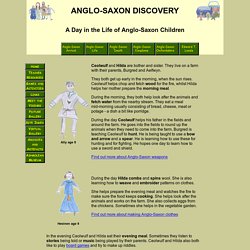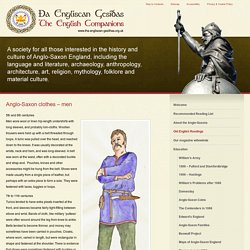

Primary History - Anglo-Saxons - Anglo-Saxons at war. Ashmolean Museum: Anglo-Saxon Discovery - Hilda and Ceolwulf's Day. Ceolwulf and Hilda are bother and sister.

They live on a farm with their parents, Burgred and Aelfwyn. They both get up early in the morning, when the sun rises. Ceolwulf helps chop and fetch wood for the fire, whilst Hilda helps her mother prepare the morning meal. During the morning, they both help look after the animals and fetch water from the nearby stream.
They eat a meal mid-morning usually consisting of bread, cheese, meat or potage - a dish a bit like porridge. During the day Ceolwulf helps his father in the fields and around the farm. Find out more about Anglo-Saxon weapons. Life in Anglo-Saxon England. 1.

Introduction The Anglo-Saxon period lasted for some six centuries, from the arrival of Germanic invaders from the continent during the early fifth century AD to the Norman Conquest of 1066. This was a time of immense political and social upheaval which saw major changes in almost all aspects of everyday life. The early pagan settlers lived mainly by farming (see Unit 9, Farming), and formed a number of separate — and warring — kingdoms.
By around 700 AD, there appears to have been a ‘Heptarchy’ of seven kingdoms (Northumbria, Mercia, East Anglia, Wessex, Essex, Sussex and Kent), while the main four in the ninth century were Northumbria, Mercia, East Anglia and Wessex. Anglo Saxons Houses and Saxon villages. We know what Saxons houses may have looked like from excavations of Anglo Saxon villages, such as the one at West Stow in the east of England.

Here, an early Anglo-Saxon village (c.420-650AD) has been carefully reconstructed where it was excavated. Using clues from the what was discovered, archeologists have reconstructed the houses as they may have looked about 1,500 years ago. We know that the Saxons built mainly in wood, although some of their stone churches remain. Anglo-Saxons houses were huts made of wood with roofs thatched with straw. Much of Britain was covered with forests. There was only one room where everybody ate, cooked, slept and entertained their friends.
The houses were built facing the sun to get as much heat and light as possible. History - Anglo-Saxon Law and Order. Anglo-Saxon clothes - men. 5th and 6th centuries Men wore wool or linen hip-length undershirts with long sleeves, and probably loin-cloths.

Woollen trousers were held up with a belt threaded through loops. A tunic was pulled over the head, and reached down to the knees. It was usually decorated at the wrists, neck and hem, and was long-sleeved. A belt was worn at the waist, often with a decorated buckle and strap-end. 7th to 11th centuries Tunics tended to have extra pleats inserted at the front, and sleeves became fairly tight-fitting between elbow and wrist. There was undoubtedly much variation according to region, period and status. Most clothes were made at home, and would almost certainly have undergone many repairs, or have been handed down, before being eventually cut up for rags or thrown away.
Underclothes were not usually dyed, but left in their natural colour, or perhaps sun-bleached. Anglo-Saxon clothes - women. 5th to 7th centuries Women wore an under-dress of linen or wool with long sleeves and a draw-string neck.

Sleeves were fastened with clasps for wealthier women, or drawn together with braid or string for poorer women. The outer dress was a tube of material, rather like a pinafore, and often called a ‘peplos’. A pair of shoulder-brooches or clasps held this onto the under-dress. A belt was worn, from which various accessories were hung. There is some linguistic evidence that shawls were worn, as well as cloaks, which were fastened either centrally or to the right shoulder with a brooch. 7th to 9th centuries Shoulder-brooches and wrist-clasps went out of fashion, and the sleeves of the over-dress now came to just below elbow-length on the arms and calf-length around the legs. Ashmolean Museum: Anglo-Saxon Discovery - Eating and Drinking.